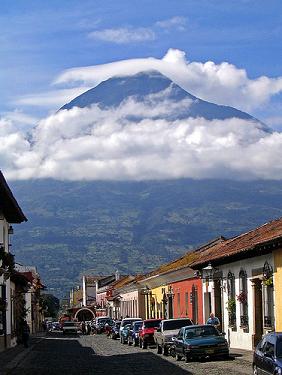 We’ve been debating the opportunities for Latin American countries to take on BPO work for a while now, and spending a few days in Guatemala has confirmed – beyond doubt – the potential of the region.
We’ve been debating the opportunities for Latin American countries to take on BPO work for a while now, and spending a few days in Guatemala has confirmed – beyond doubt – the potential of the region.
I had the pleasure of visiting Capgemini’s facility, which is quickly ramping up customer-facing F&A work for Coca-Cola Enterprises (which we picked up on here). I am going to write more about this engagement in due course, but the hybrid nearshore/offshore operating model for Finance and Accounting and Procurement is showing strong signs of being the way forward for the industry. This is also the case for many global strategic sourcing, supply management and HR BPO engagements. For example, Coca-Cola Enterprises is sourcing neashore work to Capgemini’s centers in Guatemala and Krakow, and using its Chennai operation to support these centers with non-customer facing processes.
Guatemala’s population itself is only 13.7m people, with 40% based in urban areas, however, it is the largest Central American hub with strong potential to source activities to neighboring countries, such as El Salvador and Nicaragua (see graph below) to compliment serices and keep costs low. What impressed me most meeting many operations agents and managers was the easy-to-understand English intonation, the obsession with process, the youthful energy and the discipline.
One of the major delivery centers has already made Six Sigma yellow-belt certification as a stipulation for employment among all its agents, and puts many on the green and black-belt courses on the job. The challenge for US onshore centers in the future is not only to compete on cost, but also on quality.
Key sourcing facts about Guat:
- 4.1m of its total population is “economically active”
- 80% of its population is under 30
- 80% are taught English from the age of 5
- 86% literacy rate in Guatemala City
- University-level population of over 200,000 students
- Robust telecoms infrastructure (their commerce minister was sporting three blackberries)
- 20 yeas of democracy
- 5200 feet above sea-level and 60-85 degrees all-year-round
- Strong base of investment from multi-national corporations – for example P&G, Walmart, Scotiabank, Capgemini and ACS
- Investing in windfarm projects with the Mexican government
- Manufacturing represents its major industry, but increasing exports of coffee, bananas and green tomatoes are driving economic growth
Source: Celade
The core issue behind future growth is going to be where to source the customer/partner/employee facing work versus the non-employee processes. While Philippines and India have proven themselves to be competent with voice work, the time zone differences make it difficult with complex work that requires a lot of management attention (especially during the early engagement years). As one senior sourcing executive said to me, “Guatemala is a 3 hour flight…Manila is 20”.
The business challenge for today’s enterprises is the trade-off between operating costs, times zones and overall quality. For example, if Indian costs for a set of processes are half those of Guatemala, how much more will you spend on management travel to the region? How many more FTEs will you require to compensate for exhaustive night-shifts?
The Coca-Cola Enterprises model is an example of bridging the benefits of nearshore with the low-cost advantages of offshore. They are finding a balance between all the elements that are core to their business: maintaining business relationships, lowering costs while enhancing quality and taking advantage of global sourcing to redefine their process and technology.

Guatemala: Great potential, but beware of strange foreign visitors
Posted in : Business Process Outsourcing (BPO), Finance and Accounting, Procurement and Supply Chain, Sourcing Best Practises, Sourcing Locations








Have you checked on places like the Dominican Republic or Trinidad an Tobago. Someone from Trinidad and Tobago once mentioned to me that they were looking for company’s interested in building their offshore centers there and that the govt. was more than willing to oblige with subsidies and any assistance.
Guatemala will be a good sourcing location as soon as they get their labor issues under control. They have a good skilled labor pool that produces a good quality product. But Guatemala has been mired by complaints of union busting and threats to its labor leaders. However, since they joined Dr-CAFTA they have been making strides in fixing that particular problem.
I think that in addition to Costa Rica, Guatemala is most likely the most stable place for outsourcing in Central America. I do suggest that you fully investigate the factory for financial stability, including making sure that they are paying their social security contributions. It is important to check with a labor expert that can contact the various labor unions to see the types of grievances that may be filed against the plant.
Another thing to look at is whether or not the plant that you choose has the capacity to fill the orders with out having to subcontract the work. Labor violations to DR-CAFTA are often committed by hidden out side plants that have been contracted produce the overflow.
Jorge de Tuya
I don’t agree with the nearshore argument – I think thats just a cop out. Process should go to where its done best irrespective of specious arguments like time zones, distance etc. Guatemala should, and will, score because it can do something better; not because its 3 hours from the US.
The number of FTEs in the Guatemala outsourcing industry is growing at a fast pace – evidence that an increasing number of foreign companies are taking advantage of the ripe conditions. For more insights go to my recent post at Caribbean CRM Central:
http://caribbeancrmcentral.wordpress.com/2009/04/29/the-guatemala-story-will-big-tech-and-ito-define-the-next-wave/